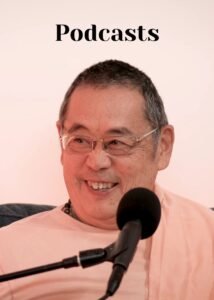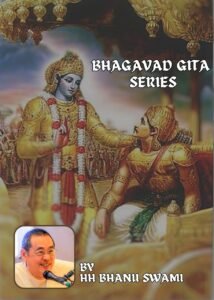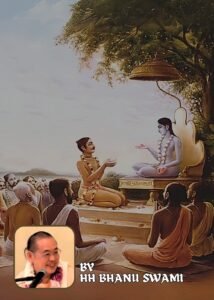Om Namo Bhagavate Vāsudevāya
Om Namo Bhagavate Vāsudevāya
Om Namo Bhagavate Vāsudevāya
nama om vishnu-padaya krishna-preshthaya bhu-tale
srimate bhaktivedanta-svamin iti namine
namas te sarasvate deve gaura-vani-pracharine
nirvishesha-shunyavadi-pashchatya-desha-tarine
jaya sri-krishna-chaitanya
prabhu nityananda
sri-adwaita gadadhara
shrivasadi-gaura-bhakta-vrinda
Hare Krishna Hare Krishna Krishna Krishna Hare Hare
Hare Rama Hare Rama Rama Rama Hare Hare
Reading from Srimad Bhagavatam Canto 11 Chapter 10 Verse 3.
ŚB 11.10.3
suptasya viṣayāloko
dhyāyato vā manorathaḥ
nānātmakatvād viphalas
tathā bhedātma-dhīr guṇaiḥ
Translation
One who is sleeping may see many objects of sense gratification in a dream, but such pleasurable things are merely creations of the mind and are thus ultimately useless. Similarly, the living entity who is asleep to his spiritual identity also sees many sense objects, but these innumerable objects of temporary gratification are creations of the Lord’s illusory potency and have no permanent existence. One who meditates upon them, impelled by the senses, uselessly engages his intelligence.
Purport
Because the fruits of material work are temporary, it ultimately does not matter whether or not one obtains them; the final result is the same. Materialistic activities can never award the highest perfection of life, Kṛṣṇa consciousness. The material intelligence, impelled by the senses, strongly desires sense gratification. As stated here (bhedātma-dhīḥ), such intelligence actually separates one from one’s real self-interest. Thus the intelligence, absorbed in that which is materially favorable and unfavorable, becomes divided in pursuit of innumerable categories of material advancement. Such divided intelligence is impotent and cannot understand the Absolute Truth, the Personality of Godhead, Śrī Kṛṣṇa. The devotees of the Lord, however, have their intelligence fixed on one point — Lord Kṛṣṇa. They meditate upon the Lord’s form, qualities, pastimes and devotees, and thus their intelligence is never separated from the Absolute Truth. As stated in Bhagavad-gītā (2.41):
vyavasāyātmikā buddhir
ekeha kuru-nandana
bahu-śākhā hy anantāś ca
buddhayo ’vyavasāyinām
“Those who are on this path are resolute in purpose, and their aim is one. O beloved child of the Kurus, the intelligence of those who are irresolute is many branched.”
If one is not Kṛṣṇa conscious, he is uselessly dreaming without any understanding of his eternal situation. The material intelligence will always devise novel means of achieving happiness, and therefore one bounces from one fruitless program of sense gratification to another, ignoring the simple fact that all material things are temporary and will disappear. In this way one’s intelligence becomes infected with material lust and greed, and such infected intelligence cannot bring one to the true goal of life. One should hear from the bona fide spiritual master whose intelligence is pure, and then one will come to Kṛṣṇa consciousness, the highest perfection of life.
HH Bhanu Swami Maharaj:
So here we have the example of the objects in a dream. So these are compared to the objects when we are not in the dream, that is when we are in waking consciousness. So the creations of objects in the dream are creations of the mind. But when we are in the dream, we think they are real. So if one sees a tiger in a dream, then one gets frightened. So it appears to be real, in spite of the fact that when we wake up we say, no, it was not real.
So in some sense the waking state is similar. We see objects and then we think this is real. When we develop spiritual consciousness, then our vision changes. However, unlike when we wake up from the dream and we say the dream was unreal, when we become elevated to spiritual consciousness, we do not say that those objects were unreal that we saw in our normal state of consciousness. However, our perception of the objects when we are not in a realized state is quite different from when we have realization. So when we are in material consciousness we look at objects of this world and then we consider them either beneficial or unbeneficial. And if it is beneficial, we desire the object. If it is not beneficial, we reject the object. And this, of course, is what we call duality. Based on iccha and dvesha, desire and hatred.
When we are in a realized state, then we understand, oh, the object is there, but it is not something we either desire or hate. When we are in material consciousness, we desire an object or hate an object, then we will do activities to attain the object or to avoid the object. When one is in a realized state, one sees the object, he has no desire to attain it, so he doesn’t do any activity for it. And he has no hatred of an object, so he doesn’t avoid it also. So he passes his life neither hating nor desiring objects of this world.
When we wake up from a dream, then we say, oh, that was false. So in one sense false, but in another sense it is also real. Where did the illusion of a tiger come from in the dream? Because we saw a real tiger in this life. So therefore that illusion was actually based upon a real experience. So the dream, in other words, oh, it is illusory, we can’t say it is completely to be rejected. It has some relationship with the real world. However, like waking up from the dream of our normal life and developing spiritual realization, still, even in the dream, there are false conceptions of what the tiger is. So when we develop a spiritual realization, then we understand that all these conceptions of the tiger are false. So therefore, a person with spiritual realization is not a friend or an enemy of any living entity or anything in this world. So this means that we do not reject that Prakriti and the objects created are real. Oh, they are real. However, our conception of them is wrong. So that is the illusion that we have to reject.
Of course, there is another philosophy, that is the Mayavada philosophy or Advaita philosophy, they say actually the object doesn’t exist at all. So when we develop spiritual realization, all objects disappear. So ultimately, nothing exists. The whole material world is false. So that is why it is called Mayavada. So vada means propounding a philosophy. So the propounding philosophy that everything is illusory, maya. Material world actually does not exist. Of course, they go further than that. They say even the Jiva does not exist. Certainly, they do not deny the consciousness of the individual Jivas. But there is also a part, we can say, some illusion there as well. So when we come out of the illusion, then we realize there is no individual consciousness, there is only one consciousness, Brahman. So in this way, matter and prakriti and material world is completely false, and the individual Jivas of this world are also false. So the only real entity is that Brahman.
However, the Vaishnavas completely reject that philosophy. And therefore we have a great emphasis in our philosophy on the fact that prakriti is real, Jiva is real, Supreme Lord is real, Time is real, karma is real. And of course, the Supreme Lord, the Jiva, prakriti and time are eternal, no beginning and no end. Karma has no beginning but can have an end. So that is a basic tenet of our philosophy. And we see even in the introduction of Bhagavad Gita, Prabhupada emphasizes this. This actually originates with Baladeva Vidyabhusana in his commentary. And so there he mentions all these things are real. And they are all eternal, except for karma. So that is the basis of Vaishnava theology. In order to have bhakti and worship the Supreme Lord, there cannot be only one entity. So we don’t think of the Jiva as illusory. And we also do not reject the material world, it is also real. And the bondage of the Jiva, the material world is real.
We find this also emphasized in the first canto of the Bhagavatam. So to write the Bhagavatam under Narada Muni’s direction, Veda Vyasa meditated. So when he meditated, what happened? Did he merge into one brahman? No, he saw Supreme Lord. He saw the Jiva. He saw maya standing behind the Lord. And so therefore the Jiva is real, maya is real, prakriti is real and Supreme Lord is real. And he also saw bhakti yoga. So bhakti yoga is spiritual, therefore it is also eternal. It is also real. So in this way, the Vaishnavas established the reality of the world, the reality of the Jiva, the reality of the Supreme Lord.
The whole purpose of doing this is to validate the process of bhakti and the goal of prema. If the Jiva is not real, there is no prema. Prema only exists because the Jiva is different from the Supreme Lord. Therefore the goal of bhakti depends on the Jiva worshipping the Lord. When the Jiva attains prema, the Jiva does not disappear. So the goal of the Jiva depends upon the difference between the Jiva and the Supreme Lord.
However, some people will protest. They will raise statements from the Upanishads. And they will say, there it says that only brahman exists and that everything is unreal. Certainly we will find many statements in the Upanishads, even in Bhagavatam, that everything is unreal except the Lord [Laughs]. But we can look at that statement, but then we can also see opposite statements. Such as the Lord created the material world [Laughs]. So therefore we do have the famous statement in the Taittiriya Upanishad, the Lord glanced and then he created everything in this material world. So if he created a material world, how can it be false? What’s the use of creating something false? You create a false creation, it’s not a creation at all, so don’t say he created anything [Laughs]. This of course is also stated at the beginning of the Brahma Sutras, which is also quoted in the first verse of Bhagavatam. So the second sutra is janmādy asya yataḥ. So what is Brahman, what is what we call Brahman, what is that thing? From it we get creation, maintenance and destruction. So that Brahman is real and the creation of the material world, the destruction of the material world is real. So we find many statements that will show the reality of the material world, the Jiva and the Supreme Lord. Now, the difference is that the Supreme Lord is independent and all the other factors, that is Jiva, material world, time and karma are dependent on the Lord. So in this way there is more difference.
Yet Lord Caitanya says, acintya bheda-abheda. So then Lord Caitanya also says everything is Abheda. Which means Advaita. But then he says it is also bheda, it is also different. So he agrees, yes there are statements in the Upanishad that talk about oneness, but then there is also difference. So there is one entity, the Supreme Lord, but also there is Supreme Lord, there is Prakriti, there is Jiva, etc. So therefore he says bheda and abheda. Only one Lord, but also there is different entities. So normally this is not logically possible. Either there is one Brahman or there is Brahman, Jiva and material nature. And therefore we have different philosophies the Mayavadis say there is only one Brahman. And Madhvacharya says no, not one that everything is different. But Lord Caitanya says no both.
So this is logically contradictory. So by normal logic it is not possible to say that. You cannot say the microphone exists and it does not exist simultaneously, it doesn’t make sense. Or the microphone is black and the microphone is white, it can’t be both, it’s got to be one or the other [Laughs]. So certainly as far as our experience in the material world with material logic and material mind and material senses, yes there is contradiction if there is opposites. But in the Supreme Lord there is no contradiction. He can be one or he can be many. Just like we say one Supreme Lord but then he has many forms. We never say there are many Ishvaras, there is only one Ishvara. But we never say that the forms of Narasimhadeva and Rama are illusory. And we also don’t say that Rama looks like Narasimhadeva [Laughs]. Yet we also say one Supreme Lord. So the Supreme Lord and his powers and his activities etc. cannot be completely comprehended by the Jivas in the material world. So therefore we say by the inconceivable power of the Lord he can be one and he can also be many. In this way then both aspects of scripture are supported. Yes, scripture says oneness, scripture says difference, both are true.
Q & A
1) In this shloka the material objects are given, we should avoid. But in the concept of Yukta Vairagya, devotee uses the material things for the service of the Lord. [not audible]
So we should not use the definition of Yukta Vairagya to increase our material attachments. Of course, because of that danger, the impersonalists completely reject material objects. So we use them, but we do have to be careful.
2) Can we understand that only devotees who have come out of bodily attachment can use Yukta Vairagya properly, rather than the neophyte devotees?
Yeah, definitely we can say that its more danger for neophyte devotee that he become attached materially.
Devotees: Grantaraj Srimad Bhagavatham Ki Jai!!! HH Bhanu Swami Maharaj Ki Jai!!!


